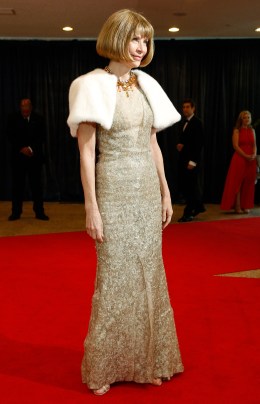
Anna Wintour, editor-in-chief of American Vogue, arrives on the red carpet at the annual White House Correspondents' Association dinner in Washington D.C., on April 27, 2013.
President Barack Obama will soon appoint a new round of ambassadors. Only 13 of 188 embassies are currently vacant, though perhaps as many as 100 others may open up as first termers rotate out. Some 30% are likely to be political, or patronage, appointments leaving the vast majority to the Foreign Service. That’s the same ratio that has been observed since George H. W. Bush’s tenure, but there are forces at work to cut back on the patronage quota.
The Administration doesn’t have a great record in this area. Obama’s nominee to be ambassador to Iraq, Brett McGurk, had to withdraw when evidence of an affair and rumors of an embarrassing sex tape emerged (though McGurk is now being considered for Deputy Assistant Secretary of State for Iraq and Iran). The Administration pulled the nomination of top fundraiser Timothy Broas to be ambassador to the Netherlands last June after he was charged with drunk driving and resisting arrest. Obama had an unexpected fight in 2011 to confirm Mari Carmen Aponte as ambassador to El Salvador when Congressional Republicans filibustered her nomination over reports that a boyfriend she’d lived with 20 years ago once worked as an agent for Fidel Castro. Aponte was eventually confirmed. And in early May, Manhattan hedge fund billionaire Marc Lasry emerged as Obama’s pick for Paris, until a New York Post cover story detailing his penchant for online gambling on a website favored by Russian mobsters forced him to withdraw.
Meanwhile, some who did get through shouldn’t have. Four patronage ambassadors tapped by Obama in his first term – to Malta, Luxembourg, Kenya and the Bahamas — were so embarrassed that they had to resign following scathing reviews by the State Department’s Inspector General. The ambassadors to Luxembourg and Kenya were accused of mistreating their staffs, “dysfunction” leading to “low staff morale, according to the IG reports. The situation in Luxembourg was so bad, the IG said, that staff was choosing to curtail their assignments in favor of tours in Afghanistan and Iraq. The reports said the ambassadors to Malta and Bahamas neglected their posts in favor of other pursuits. “Part of the problem highlighted by Luxembourg and Malta is it’s not just holding cocktails, it’s about managing bureaucrats from two dozens agencies,” says Dennis Jett, a professor of international affairs at Pennsylvania State University who is writing a book entitled, American Ambassadors: Where They Come From, Where They Go, and Why They Still Matter. “It says something when we send off amateurs to these countries. They ought to have credentials and experience and management abilities, in addition to just bundling hundreds of thousands of dollars.”
All of this drama makes it a little odd that bold-faced names are now being floated as potential high-level ambassadors in Obama’s second term. Vogue editor Anna Wintour has been mentioned for both London and Paris, though it looks likely now that London will go to Obama’s 2012 campaign finance chairman Matthew Barzun, who’s married to the heiress of the Jack Daniels whisky empire. Caroline Kennedy is being considered for Tokyo and attorney John Phillips, who is married to Linda Douglass, a former television network reporter who worked on Obama’s 2008 campaign, is in the running for Italy. The Canadian press reported that Goldman Sachs partner and mega fundraiser Bruce Heyman will be the newest U.S. envoy to Ottawa. Others under consideration for spots, according to the widely read Hollywood Reporter, include White House decorator Michael Smith, television producer Colleen Bell, Tennis Channel chief Ken Solomon and, even, actor George Clooney. Just where each might be heading is anyone’s guess.
Second terms, to some extent, often see second string choices get job offers as the A-list folks burn out. Appointments often go to fundraisers who were asked to be patient in the first term or friends and political allies the President can no longer put off. Obama raised more than $1 billion in the 2012 campaign cycle, which means there are a lot of fundraisers to thank. Some 300 top supporters are hoping for just 30-odd slots. Europe is the prime destination for most patronage appointments. In the last 60 years, 72% of U.S. ambassadors to Western Europe and the Caribbean have been political appointees, according to the American Foreign Service Association. No political appointee has even been posted to Central Asia and only 14% of ambassadors to Africa and the Middle East have been non-career Foreign Service officers.
But all diplomatic posts are getting more complicated, not less. In April, Ronald Neumann, a former U.S. ambassador to Afghanistan and president of the American Academy of Diplomacy, Susan Johnson, president of the American Foreign Service Association, and Thomas Pickering, an Obama advisor who led the investigation into Benghazi, published an editorial entitled, “Presidents Are Breaking the Foreign Service.” The trio recommended that presidents limit themselves to only 10% of ambassadors as political appointees and that Congress do a better job ensuring those appointed are up to the job in confirmation hearings. In the wake of the deaths in September of Libyan Ambassador Chris Stevens and State Department employee Anne Smedinghoff in an April bombing in Afghanistan, “it’s very clear that this is an age of high risk diplomacy,” Pickering explained. Ambassadors “need to know and understand not just managerial competence they also need to understand how and in what way the government operates. We have seen absenteeism in some of the appointees. Others don’t have the kind of intimate area knowledge or language knowledge needed. All of this can lead to mistakes that we can increasingly ill afford.”

